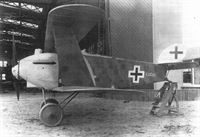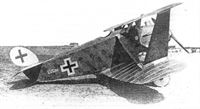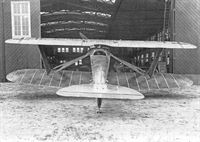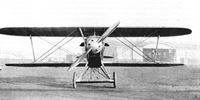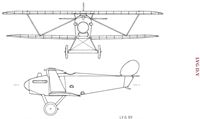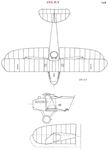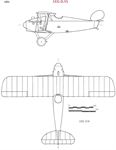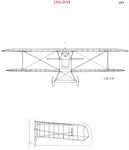
Описание
Страна: Германия
Год: 1918
Fighter
O.Thetford, P.Gray German Aircraft of the First World War (Putnam)
L.V.G. D V
Another 195 h.p. Benz-powered prototype, the D V of 1918 reverted to a slab-sided ply-covered fuselage. Most singular feature was the juxtapositioning of the wing surfaces, the lower one being of much broader chord, and the main lifting surface. The narrow-chord upper-wing panels pivoted differentially outboard of the centre-section, the entire surface of both wings acting as "ailerons" to provide lateral manoeuvre.
L.V.G. D VI
Final fighter to emerge from the L.V.G. stable was this aggressive-looking D VI. It had many unique features: chin-type radiator air intake, swept lower wing, metal strap bracing, "I"-type interplane struts and a lifting surface on the axle as featured on Fokker aircraft. The almond-shaped rudder was pivoted on a tubular spar, and would appear to have been a highly vulnerable assembly. Engine, 195 h.p. Benz Bz IIIb.
Описание:
- O.Thetford, P.Gray German Aircraft of the First World War (Putnam)
- Jane's All The World Aircraft 1919
- W.Green, G.Swanborough The Complete Book of Fighters
- J.Herris LVG Aircraft of WWI. Vol.3: Types C.VI-C.XI & Fighters (A Centennial Perspective on Great War Airplanes 36)
Фотографии
-
J.Herris - LVG Aircraft of WWI. Volume 3: Types C.VI-C.XI & Fighters /Centennial Perspective/ (36)
The LVG D.V had little in common with the earlier D.IV except use of the geared version of the same experimental Benz V-8 engine.
Differentially pivoting upper wing tips were an unusual feature of the D V. -
M.Dusing - German & Austro-Hungarian Aero Engines of WWI. Vol.3 /Centennial Perspective/ (66)
The prototype LVG D.V fighter was powered by the Benz Bz IIIbm V-8; note the radiator inlet under the nose.
This view of the LVG D.V shows the cooling air inlet underneath the propeller, probably the only successful new design feature incorporated in the aircraft. (Peter M. Grosz Collection/SDTB) -
J.Herris - LVG Aircraft of WWI. Volume 3: Types C.VI-C.XI & Fighters /Centennial Perspective/ (36)
This view of the right side of the LVG D.V does nothing to improve the aesthetics of the aircraft nor inspire greater confidence in its flying qualities.
-
J.Herris - LVG Aircraft of WWI. Volume 3: Types C.VI-C.XI & Fighters /Centennial Perspective/ (36)
This rearview of the LVG D.V shows the over-size lower wing and narrow-chord upper wing with seams where the differentially rotating outer panels were attached to the fixed center section. Massive struts were used in place of landing wires and combined with the I-struts to eliminate the flying wires. There is a simple and important reason that successful biplanes do not have lower wings larger than their upper wings; most of the lift of a biplane wing cellule is generated by the upper wing. The use of differentially rotating outer panels in place of ailerons is also avoided due to the potential for control 'snatch', or over-centering of the controls leading to full control deflection. Control snatch can occur with badly rigged ailerons as well (a surprise that, in the author's experience, when near stall speed can produce an immediate spin and a lot of adrenalin), but is not as likely. (Peter M. Grosz Collection/SDTB)
-
M.Dusing - German Aviation Industry in WWI. Volume 1 /Centennial Perspective/ (84)
The LVG D.VI used the ungainly fuselage and experimental Benz V-8 engine used in the earlier D.V coupled to an entirely new wing cellule. The D.VI was the final LVG single-seat fighter design built.
An L.V.G. Single-seater Scout produced towards the end of the War, presumably of the D.VI class (195 h.p. Benz Bz IIIb.).
Last of the LVG fighters, the D VI was not tested until the last week of World War I. -
M.Dusing - German & Austro-Hungarian Aero Engines of WWI. Vol.3 /Centennial Perspective/ (66)
The LVG D.VI was the last prototype fighter designed by LVG. Like the LVG D.V, the engine was the Benz Bz IIIbo V-8. Both the D.V and D.VI had similar fuselages with vulnerable rudders but entirely different wing cellules. with the powerful rotary engines from Oberursel or those from Goebel and Siemens-Halske that such engines had reached their performance limits. It also became apparent that the rotating masses of the high-power rotary engines could hardly be controlled.
-
W.Green, G.Swanborough - The Complete Book of Fighters
Differentially pivoting upper wing tips were an unusual feature of the D V.

